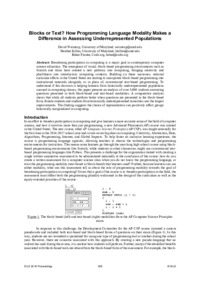Blocks or Text?How Programming Language Modality Makes a Difference in Assessing Underrepresented Populations
|
 |
 Diese Seite wurde seit 6 Jahren inhaltlich nicht mehr aktualisiert.
Unter Umständen ist sie nicht mehr aktuell.
Diese Seite wurde seit 6 Jahren inhaltlich nicht mehr aktualisiert.
Unter Umständen ist sie nicht mehr aktuell.
 Zusammenfassungen
Zusammenfassungen
 Broadening participation in computing is a major goal in contemporary computer
science education. The emergence of visual, block-based programming environments such as
Scratch and Alice have created a new pathway into computing, bringing creativity and
playfulness into introductory computing contexts. Building on these successes, national
curricular efforts in the United States are starting to incorporate block-based programming into
instructional materials alongside, or in place of, conventional text-based programming. To
understand if this decision is helping learners from historically underrepresented populations
succeed in computing classes, this paper presents an analysis of over 5,000 students answering
questions presented in both block-based and text-based modalities. A comparative analysis
shows that while all students perform better when questions are presented in the block-based
form, female students and students from historically underrepresented minorities saw the largest
improvements. This finding suggests the choice of representation can positively affect groups
historically marginalized in computing.
Broadening participation in computing is a major goal in contemporary computer
science education. The emergence of visual, block-based programming environments such as
Scratch and Alice have created a new pathway into computing, bringing creativity and
playfulness into introductory computing contexts. Building on these successes, national
curricular efforts in the United States are starting to incorporate block-based programming into
instructional materials alongside, or in place of, conventional text-based programming. To
understand if this decision is helping learners from historically underrepresented populations
succeed in computing classes, this paper presents an analysis of over 5,000 students answering
questions presented in both block-based and text-based modalities. A comparative analysis
shows that while all students perform better when questions are presented in the block-based
form, female students and students from historically underrepresented minorities saw the largest
improvements. This finding suggests the choice of representation can positively affect groups
historically marginalized in computing. Dieses Konferenz-Paper erwähnt ...
Dieses Konferenz-Paper erwähnt ...
 Dieses Konferenz-Paper erwähnt vermutlich nicht ...
Dieses Konferenz-Paper erwähnt vermutlich nicht ... 
 Nicht erwähnte Begriffe | Informatik-Didaktik, Informatikunterricht in der Schule |
 Tagcloud
Tagcloud
 Zitationsgraph
Zitationsgraph
 Zitationsgraph (Beta-Test mit vis.js)
Zitationsgraph (Beta-Test mit vis.js)
 Zeitleiste
Zeitleiste
 1 Erwähnungen
1 Erwähnungen 
- Phantoms On A Cliff Edge? - Block-based vs Text-based Assessments of Coding Skill (Serje Robidoux) (2018)


 Volltext dieses Dokuments
Volltext dieses Dokuments
 Anderswo suchen
Anderswo suchen 
 Beat und dieses Konferenz-Paper
Beat und dieses Konferenz-Paper
Beat hat Dieses Konferenz-Paper während seiner Zeit am Institut für Medien und Schule (IMS) ins Biblionetz aufgenommen. Beat besitzt kein physisches, aber ein digitales Exemplar. (das er aber aus Urheberrechtsgründen nicht einfach weitergeben darf). Es gibt bisher nur wenige Objekte im Biblionetz, die dieses Werk zitieren.









 Programmieren
Programmieren Scratch
Scratch









 , 1442 kByte)
, 1442 kByte)  Biblionetz-History
Biblionetz-History